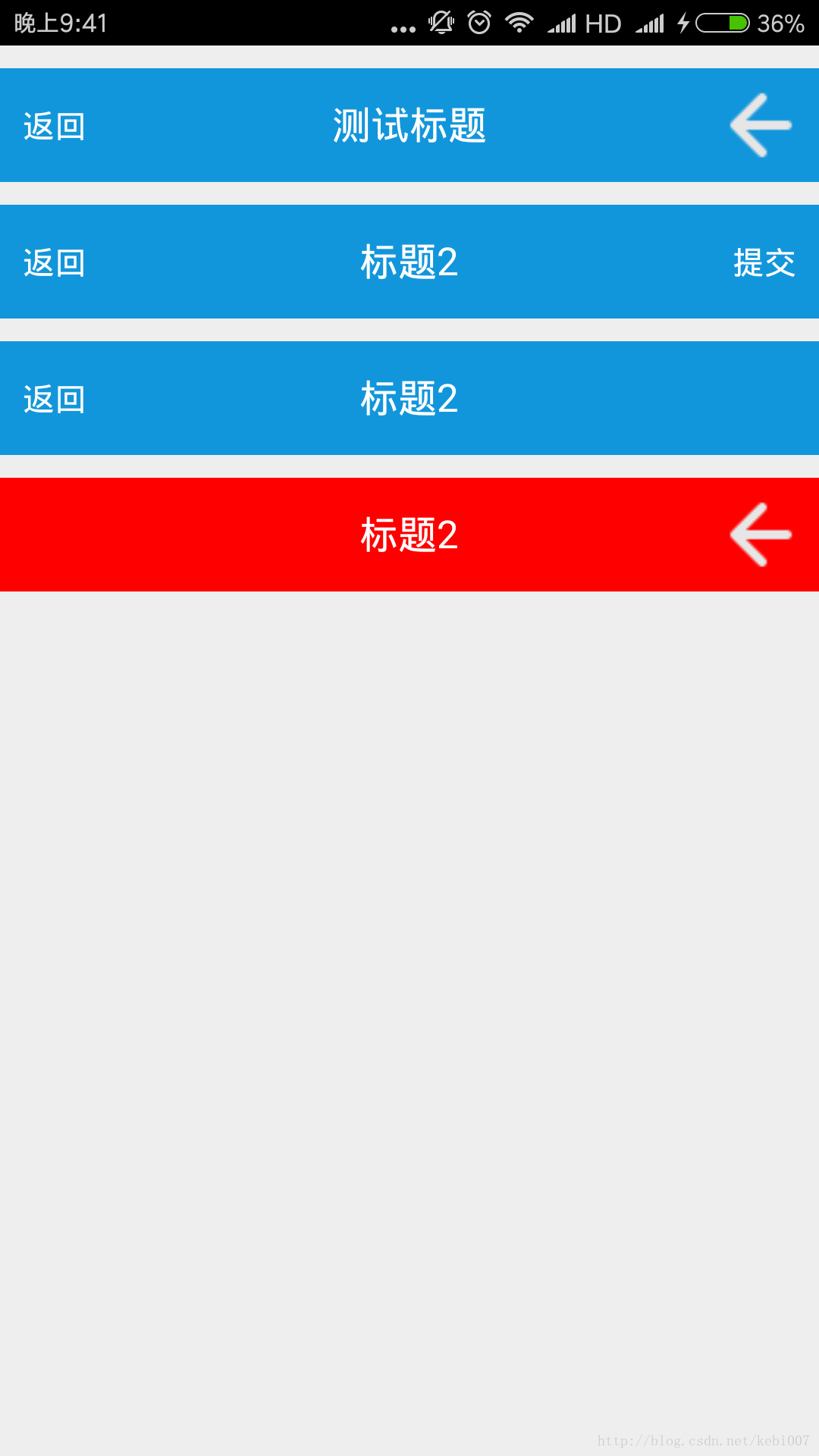自定义控件的基本要求
这篇文章就当是自定义控件入门,看了几篇android关于自定义控件的文章,了解了一下,android自定义控件主要有3种方式:
- 自绘控件:继承View类,所展示的内容在OnDraw方法中绘制出来
- 组合控件:不需要绘制视图显示的内容,只用系统原生的控件,将几个控件组合起来,(这就是这篇文章要写的自定义标题栏)
- 继承控件:继承原生的控件类,在原生的属性上增加新的功能。
这篇文章所要写的是第二种方式组合控件,来实现自定义标题栏。总结这4点实现一个组合控件的基本要求:
1.在XML布局中可设置组合控件自定义的属性。
2.在代码总可设置属性和方法。
3.UI交互:布局美观,按下,点击等效果。
4.自定义回调事件
先来看看最终实现的效果图: 
自定义标题栏的实现(使用的是include标签)
自定义标题栏的好处:
- 提高布局效率
- 降低布局文件的维护成本
- 方便使用,容易扩展
- 降低标题栏和Activity代码逻辑的耦合
我们先来看看布局文件:TitleBar.axml
<?xml version="1.0" encoding="utf-8"?>
<RelativeLayout xmlns:android="http://schemas.android.com/apk/res/android"
android:layout_width="match_parent"
android:layout_height="56dp">
<Button
android:id="@+id/titleBar_left_btn"
android:layout_width="wrap_content"
android:layout_height="wrap_content"
android:layout_alignParentLeft="true"
android:layout_centerVertical="true"
android:layout_marginLeft="5dp"
android:text="返回"
android:drawableLeft="@drawable/icon_white_arrow_left"
android:background="@android:color/transparent"
android:textSize="14sp" />
<TextView
android:id="@+id/title_bar_title"
android:layout_width="wrap_content"
android:layout_height="wrap_content"
android:layout_centerInParent="true"
android:text="测试标题"
android:singleLine="true"
android:textSize="17sp" />
<Button
android:id="@+id/titleBar_right_btn"
android:layout_width="wrap_content"
android:layout_height="wrap_content"
android:layout_alignParentRight="true"
android:layout_centerVertical="true"
android:layout_marginLeft="5dp"
android:text="提交"
android:textSize="14sp"
android:background="@android:color/transparent"/>
</RelativeLayout>然后在需要的地方通过include标签引用
<?xml version="1.0" encoding="utf-8"?>
<LinearLayout xmlns:android="http://schemas.android.com/apk/res/android"
android:orientation="vertical"
android:layout_width="match_parent"
android:layout_height="match_parent">
<include layout="@layout/TitleBar" />
</LinearLayout>在MainActivity中添加单击事件,或者设置属性
[Activity(Label = "CustomeTitleBar", MainLauncher = true, Icon = "@drawable/icon")]
public class MainActivity : Activity
{
private TextView title_bar_title;
private Button title_bar_left_btn;
private Button title_bar_right_btn;
protected override void OnCreate(Bundle bundle)
{
base.OnCreate(bundle);
SetContentView (Resource.Layout.Main);
title_bar_left_btn = FindViewById<Button>(Resource.Id.titleBar_left_btn);
title_bar_right_btn = FindViewById<Button>(Resource.Id.titleBar_right_btn);
title_bar_title = FindViewById<TextView>(Resource.Id.title_bar_title);
title_bar_title.Text = "新的标题";
title_bar_left_btn.Click += (s, e) => {
Finish();
};
title_bar_right_btn.Click += (s, e) =>
{
Toast.MakeText(this,"提交",ToastLength.Short).Show();
};
}
}上面的这种方式与我们自定义控件的要求相差较远,不能自定义属性,不能事件的回调。并不推荐这种方式。如果说一直用include标签的话,这个自定义标题栏好像是写给自己用的似的。
自定义标题栏的实现(自定义属性、回调事件)
(1)定义标题栏的组合布局
我们还是写来自定义一个布局,还是用上面的那个布局,不过最外层的根布局RelativeLayout就不要了,使用merge标签,避免这种嵌套布局
<?xml version="1.0" encoding="utf-8"?>
<merge xmlns:android="http://schemas.android.com/apk/res/android">
<Button
android:id="@+id/titleBar_left_btn"
android:layout_width="wrap_content"
android:layout_height="wrap_content"
android:layout_alignParentLeft="true"
android:layout_centerVertical="true"
android:layout_marginLeft="5dp"
android:gravity="left|center_vertical"
android:background="@android:color/transparent"
android:textSize="14sp" />
<TextView
android:id="@+id/title_bar_title"
android:layout_width="wrap_content"
android:layout_height="wrap_content"
android:layout_centerInParent="true"
android:singleLine="true"
android:textSize="17sp" />
<Button
android:id="@+id/titleBar_right_btn"
android:layout_width="wrap_content"
android:layout_height="wrap_content"
android:layout_alignParentRight="true"
android:layout_centerVertical="true"
android:layout_marginRight="5dp"
android:background="@android:color/transparent"
android:gravity="right|center_vertical"
android:textSize="14sp" />
</merge>(2)自定标题栏相关的自定义属性
在values文件夹新建一个xml文件attrs.xml,关于android中自定义属性format的取值类型有以下这些:
- reference:如android:background = “@drawable/图片ID”
- color:如android:textColor = “#000000”
- boolean:如android:focusable = “false”
- dimenion:如android:layout_width = “10dp”
- float :如android:fromAlpha = “1.0”
- integer:如android:background = “@drawable/图片ID”
- string:如android:text=”123”
- fraction:百分数如:android:pivotY = “300%”
- enum:如android:orientation=”vertical”
<?xml version="1.0" encoding="utf-8" ?>
<resources>
<declare-styleable name="CustomeTitleBar">
<attr name="title_background_color" format="color"/>
<attr name="title_text" format="string"/>
<attr name="title_text_color" format="color"/>
<attr name="right_button_text" format="string"/>
<attr name="right_button_text_color" format="color"/>
<attr name="right_button_drawable" format="reference|integer"/>
<attr name="right_button_visible" format="boolean"/>
<attr name="left_button_text" format="string"/>
<attr name="left_button_text_color" format="color"/>
<attr name="left_button_drawable" format="reference|integer"/>
<attr name="left_button_visible" format="boolean"/>
</declare-styleable>
</resources>(3)自定义标题栏代码的实现,根据不同的需求继承不同的原生ViewGroup类,这里继承的是RelativeLayout,也可以LinearLayout、EditText。
public class MyTitleBar : RelativeLayout
{
private TextView title_bar_title;
private Button title_bar_left_btn;
private Button title_bar_right_btn;
public MyTitleBar(Context context, IAttributeSet attrs) : base(context, attrs)
{
//base(context, attrs);
LayoutInflater.From(context).Inflate(Resource.Layout.TitleBar, this, true);
title_bar_left_btn = FindViewById<Button>(Resource.Id.titleBar_left_btn);
title_bar_right_btn = FindViewById<Button>(Resource.Id.titleBar_right_btn);
title_bar_title = FindViewById<TextView>(Resource.Id.title_bar_title);
try
{
TypedArray attributes = context.ObtainStyledAttributes(attrs, Resource.Styleable.CustomeTitleBar);
if (attributes != null)
{
//titlebar 背景颜色
int titleBarBackground = attributes.GetResourceId(Resource.Styleable.CustomeTitleBar_title_background_color,Resource.Color.color_primary);
SetBackgroundResource(titleBarBackground);
//左边按钮
//是否显示
bool leftButtonVisible = attributes.GetBoolean(Resource.Styleable.CustomeTitleBar_left_button_visible, true);
if (leftButtonVisible)
{
title_bar_left_btn.Visibility = ViewStates.Visible;
}
else
{
title_bar_left_btn.Visibility = ViewStates.Gone;
}
//设置左边按钮的文字和图标(二者只能选其一)
string leftButtonText = attributes.GetString(Resource.Styleable.CustomeTitleBar_left_button_text);
if (!string.IsNullOrEmpty(leftButtonText))
{
title_bar_left_btn.Text = leftButtonText;
//设置左边按钮的文字颜色
Color leftButtonTextColor = attributes.GetColor(Resource.Styleable.CustomeTitleBar_left_button_text_color, Color.White);
title_bar_left_btn.SetTextColor(leftButtonTextColor);
}
else //(不设置文本,就只能设置图标)
{
int leftButtonDrawable = attributes.GetResourceId(Resource.Styleable.CustomeTitleBar_left_button_drawable, Resource.Drawable.icon_white_arrow_left);
if (leftButtonDrawable != -1)
{
Drawable drawable = Resources.GetDrawable(leftButtonDrawable);
drawable.SetBounds(0, 0, drawable.MinimumWidth,drawable.MinimumHeight);//不设置这句图标显示不出来
title_bar_left_btn.SetCompoundDrawables(drawable,null,null,null);
}
}
//右边按钮
//是否显示
bool rightButtonVisible = attributes.GetBoolean(Resource.Styleable.CustomeTitleBar_right_button_visible, true);
if (rightButtonVisible)
{
title_bar_right_btn.Visibility = ViewStates.Visible;
}
else
{
title_bar_right_btn.Visibility = ViewStates.Gone;
}
//设置左边按钮的文字和图标(二者只能选其一)
string rightButtonText = attributes.GetString(Resource.Styleable.CustomeTitleBar_right_button_text);
if (!string.IsNullOrEmpty(rightButtonText))
{
title_bar_right_btn.Text = rightButtonText;
//设置左边按钮的文字颜色
Color leftButtonTextColor = attributes.GetColor(Resource.Styleable.CustomeTitleBar_right_button_text_color, Color.White);
title_bar_right_btn.SetTextColor(leftButtonTextColor);
}
else //(不设置文本,就只能设置图标)
{
int rightButtonDrawable = attributes.GetResourceId(Resource.Styleable.CustomeTitleBar_right_button_drawable, Resource.Drawable.icon_white_arrow_left);
if (rightButtonDrawable != -1)
{
Drawable drawable = Resources.GetDrawable(rightButtonDrawable);
drawable.SetBounds(0,0,drawable.MinimumHeight,drawable.MinimumHeight);
title_bar_right_btn.SetCompoundDrawables(null, null,drawable, null);
}
}
//处理标题
string titleText = attributes.GetString(Resource.Styleable.CustomeTitleBar_title_text);
if (!string.IsNullOrEmpty(titleText))
{
title_bar_title.Text = titleText;
}
Color color = attributes.GetColor(Resource.Styleable.CustomeTitleBar_title_text_color,Color.White);
title_bar_title.SetTextColor(color);
attributes.Recycle();
}
}
catch (Exception ex)
{
System.Diagnostics.Debug.Write(ex.ToString());
}
}
//设置事件的监听
public void SetTitleClickListener(IOnClickListener onClickListener)
{
if (onClickListener != null)
{
title_bar_left_btn.SetOnClickListener(onClickListener);
title_bar_right_btn.SetOnClickListener(onClickListener);
}
}
//获取左边的Button
public Button GetTitleBarLeftBtn()
{
return title_bar_left_btn;
}
//获取右边的Button
public Button GetTitleRightBtn()
{
return title_bar_right_btn;
}
//获取标题
public TextView GetTitleBarTitle()
{
return title_bar_title;
}
}(4)使用自定义标题栏,并且自定义属性
<?xml version="1.0" encoding="utf-8"?>
<LinearLayout xmlns:android="http://schemas.android.com/apk/res/android"
xmlns:mview="http://schemas.android.com/apk/res-auto"
android:orientation="vertical"
android:layout_width="match_parent"
android:layout_height="match_parent">
<CustomeTitleBar.MyTitleBar
android:id="@+id/myTitleBar"
android:layout_width="match_parent"
android:layout_height="50dp"
android:layout_marginTop="10dp"
mview:title_text="测试标题"
mview:right_button_text=""
mview:right_button_text_color="@color/color_white"
mview:right_button_visible="true"
mview:left_button_text="返回"/>
<CustomeTitleBar.MyTitleBar
android:id="@+id/myTitleBar"
android:layout_width="match_parent"
android:layout_height="50dp"
android:layout_marginTop="10dp"
mview:title_text="标题2"
mview:right_button_text="提交"
mview:right_button_text_color="@color/color_white"
mview:left_button_text="返回"
mview:left_button_text_color="@color/color_white"/>
<CustomeTitleBar.MyTitleBar
android:id="@+id/myTitleBar"
android:layout_width="match_parent"
android:layout_height="50dp"
android:layout_marginTop="10dp"
mview:title_text="标题2"
mview:right_button_visible="false"
mview:left_button_text="返回"
mview:left_button_text_color="@color/color_white"/>
<CustomeTitleBar.MyTitleBar
android:id="@+id/myTitleBar"
android:layout_width="match_parent"
android:layout_height="50dp"
android:layout_marginTop="10dp"
mview:title_text="标题2"
mview:title_background_color="@color/color_red"
mview:right_button_text_color="@color/color_white"
mview:left_button_text="返回"
mview:left_button_text_color="@color/color_red"/>
</LinearLayout>上面的代码基本实现了与activity逻辑代码的分离、UI界面要求、可配置自定义属性的要求,可最关键的事件的回调还没写,的确这是最核心的地方,这个自定义标题栏的两个按钮的单击事件最终还是要在activity中去调用。
这个就留着下次再写吧。
如果觉得还有点懵逼的话,看看github:https://github.com/MaChuZhang/Xamarin-Android-Custom-View/tree/master/CustomeTitleBar
作者:张林
标题:xamarin android自定义标题栏(自定义属性、回调事件)
原文地址:http://blog.csdn.net/kebi007/article/details/75365917
转载随意注明出处